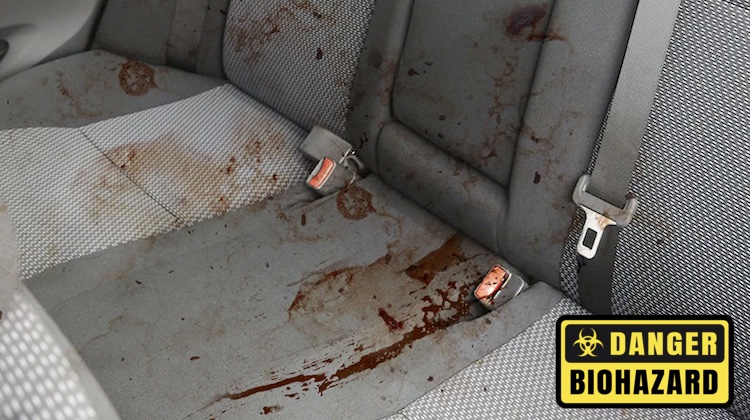
If you work in auto upholstery long enough, someone will eventually roll into your shop with a car that’s contaminated with blood, urine or some other bodily fluid. It comes with the territory. Maybe the vehicle was in a crash, or maybe the owner had a medical emergency. Whatever the reason, it’s not unusual and it can be dangerous if you’re not careful.
These situations don’t just smell bad. They expose you to real pathogens like hepatitis, HIV, MRSA and a long list of bacteria that can survive on surfaces longer than you might think. The good news is that with the right precautions you can keep yourself safe while still doing the job.
Here are some steps upholsterers should take whenever they find themselves working in a contaminated vehicle.
1. Do a visual assessment before touching anything
Before you start pulling seats or tearing down panels, take a slow look around. Identify where the fluids are, how much contamination is present and whether it has soaked into foam, fabric or carpet. This helps you plan your approach and decide whether the job requires professional biohazard remediation before you even touch it.
2. Wear personal protective equipment
A pair of shop gloves is not enough. You need proper PPE.
- Disposable nitrile gloves. Double up for added protection.
- Eye protection. Fluids can splash when cutting, pulling or spraying cleaners.
- A proper respirator. A P100 or N100 filter protects against airborne particles and potential pathogens.
- Protective clothing. Disposable Tyvek suits or at least long sleeves that can be washed immediately afterward.
A good rule of thumb: if it looks bad, treat it like it is bad.
3. Ventilate the space
Open the doors and windows. Set up fans. Airflow helps reduce odors and lowers your exposure to airborne contaminants. Never work in a closed garage while dealing with biological messes. A well ventilated area also makes chemical disinfectants safer to use.
4. Use EPA approved disinfectants
Don’t rely on household cleaners. Look for products rated by the Environmental Protection Agency (EPA) for bloodborne pathogens. Make sure you follow the recommended contact time on the label. Spraying and immediately wiping doesn’t sanitize anything. Let the product sit so it can do its job.
5. Remove and contain contaminated materials properly
Once fluids soak into foam, carpet padding or insulation, those materials often can’t be saved. Bag them in thick contractor bags, seal them and follow your local disposal requirements. Never toss bio-contaminated materials in your regular shop trash.
6. Treat sharp objects like needles as a real possibility
Anytime you’re working in a car that has biological contamination, assume there could be sharp objects hidden in seats, carpets or panels. Use tools rather than your hands to probe, lift or shift materials. Keep a puncture resistant container nearby in case you find anything.
7. Never eat or drink while you work
This should be obvious but it’s worth saying. Don’t touch your face, eat, drink, smoke or vape until you’re fully out of the work area and have washed your hands thoroughly.
8. Wash up immediately after the job
As soon as you finish the job, clean yourself up. Remove your PPE safely, wash your hands and arms with hot soapy water and change your clothes. Don’t keep contaminated clothing in your shop. Wash it at home on a hot cycle or dispose of it if you used disposables.
9. Know when to call a biohazard remediation company
Some jobs are simply too hazardous. If the contamination is extensive, has soaked deeply into foam and insulation or involves decomposition, it’s better to bring in a certified biohazard cleaning crew. These professionals have specialized training and equipment that most upholstery shops do not. Your health and your shop’s liability are more important than forcing a job you shouldn’t be doing.
10. Know your limits and be willing to turn jobs away
There is no shame in saying no. If a vehicle makes you uncomfortable, if the contamination is more than you’re prepared to handle or if the risk outweighs the reward, walk away. You are an upholsterer, not a hazmat technician. Protecting yourself, your employees and your business reputation matters more than taking a job that feels unsafe.
In short, these situations are never pleasant, but they are manageable. Preparation and proper precautions can go a long way toward keeping you safe on the job.
Recent Comments